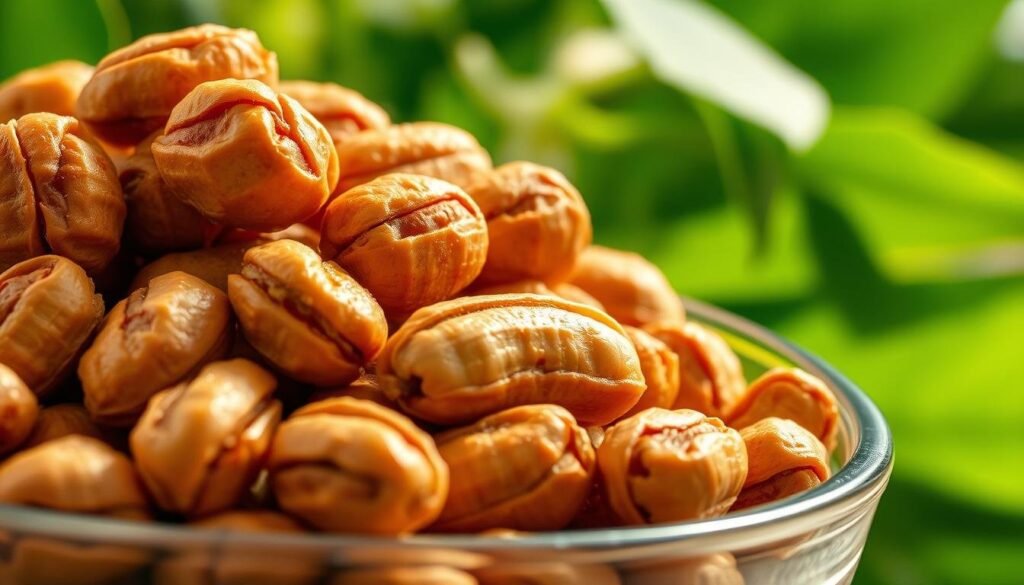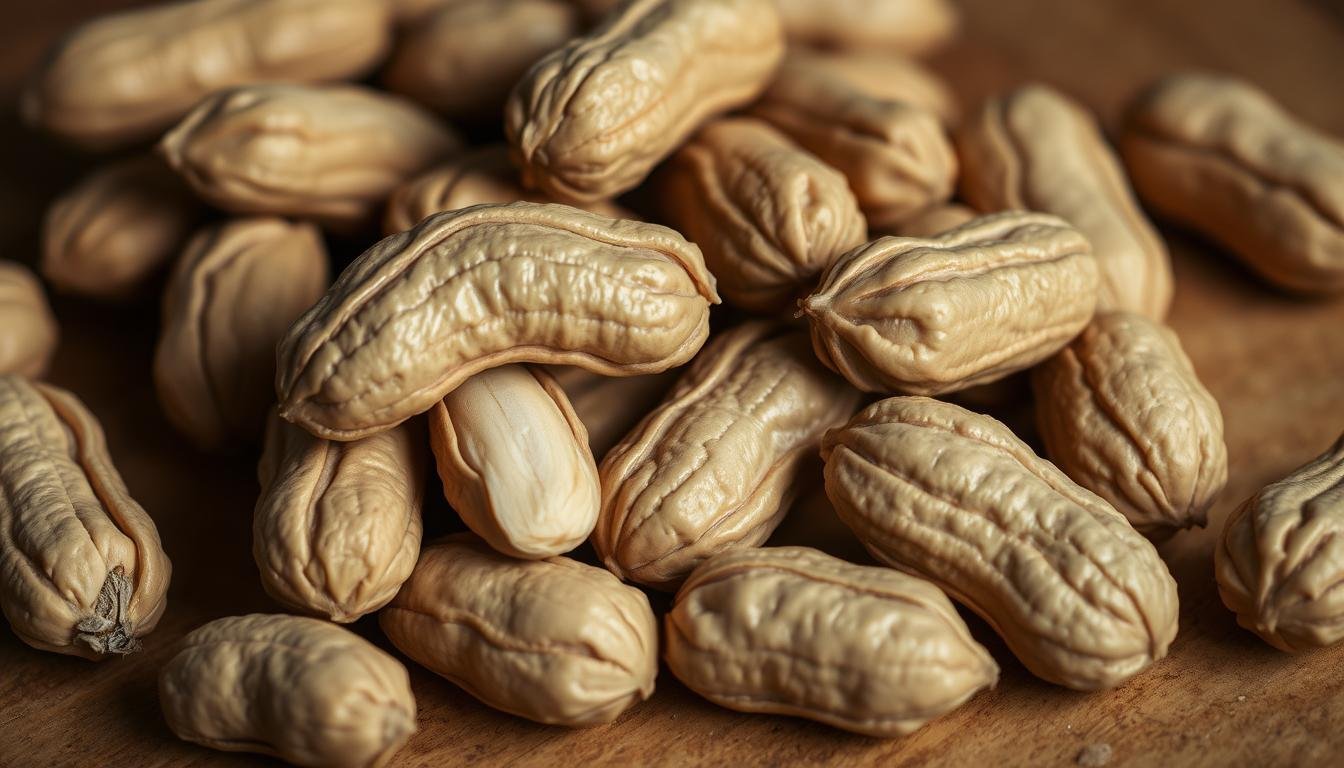Boiled peanuts are a favorite snack in many places, especially in the southern United States. They have a unique taste and texture. But, have you ever wondered if it’s okay to eat the shells too?
Eating peanut shells is a topic of debate. Some people enjoy them without any problems, while others are worried about their safety. Boiled peanuts are made by soaking raw peanuts in saltwater and then boiling them until they’re soft. But, what about the shells?
As you explore the world of boiled peanuts, it’s important to know the good and bad of eating their shells. This article will help clear up the safety and nutritional aspects of eating boiled peanut shells.
Contents
- 1 What Are Boiled Peanuts?
- 2 Can You Eat the Shell of Boiled Peanuts?
- 3 Safety Considerations of Eating Boiled Peanut Shells
- 4 Nutritional Benefits and Drawbacks
- 5 How to Prepare and Enjoy Boiled Peanuts
- 6 Conclusion
- 7 FAQ
- 7.1 Are boiled peanuts safe to eat?
- 7.2 What are the nutritional benefits of boiled peanuts?
- 7.3 Can you eat the shells of boiled peanuts?
- 7.4 Are there any risks associated with eating boiled peanut shells?
- 7.5 How can you minimize the risks of eating boiled peanuts?
- 7.6 Can boiled peanuts be seasoned or flavored?
- 7.7 How should boiled peanuts be stored?
- 7.8 Can boiled peanuts be used in recipes?
What Are Boiled Peanuts?
Boiling peanuts turns raw peanuts into a soft, salty snack. They are soaked in water and then boiled in saltwater. This makes them tender and gives them a unique taste.
In the Southern United States, boiling peanuts is a common way to prepare them. Recipes can add extra seasonings or spices to make the flavor even better.
There are several ways to boil peanuts, like using a stovetop, slow cooker, or pressure cooker. Each method has its own benefits, like faster cooking times or being easier to use.
How to prepare boiled peanuts can also differ. Some people use raw peanuts from farms, while others buy them from stores.
| Boiling Method | Cooking Time | Flavor Profile |
|---|---|---|
| Stovetop | 1-2 hours | Traditional, salty |
| Slow Cooker | 4-6 hours | Mild, savory |
| Pressure Cooker | 30-60 minutes | Quick, flavorful |
Knowing how boiled peanuts are made is key to understanding their safety. The boiling process changes the peanuts’ texture and affects the shells.
Can You Eat the Shell of Boiled Peanuts?
Many people wonder if boiled peanut shells are safe to eat. Boiled peanuts are a favorite snack, but the question of their shells’ safety is common.
Peanut shells are mostly fiber and other hard-to-digest stuff. They’re not poisonous, but eating them might upset your stomach. In rare cases, they could even block your digestive system.
Composition of Peanut Shells
Peanut shells are made of several things, including:
- Fiber
- Lignin
- Cellulose
The exact mix can change based on the peanut type and where it grows. Here’s what they usually contain:
| Component | Percentage |
|---|---|
| Fiber | 60-70% |
| Lignin | 10-20% |
| Cellulose | 5-15% |
In some places, eating peanut shells is common. But, it’s important to think about the health risks. If you eat them, do it in small amounts.
Eating boiled peanut shells can affect people differently. It’s important to know the risks and benefits. Even though they’re not usually eaten, knowing what they’re made of can help you decide.
In short, peanut shells are not poisonous, but eating them is a complex issue. They can upset your stomach or even block your digestive system. So, if you eat them, do it in small amounts.
Safety Considerations of Eating Boiled Peanut Shells
When you eat boiled peanuts, knowing the safety of the shells is key. Boiled peanuts are a favorite snack, but the shells can be risky. This is especially true for kids and people with allergies.
Eating boiled peanut shells comes with some dangers. The main risks are allergic reactions and choking. It’s important to know these risks to enjoy boiled peanuts safely.
Allergic reactions to peanuts are a big worry. Even if you’re not allergic to peanuts, the shells can still cause problems. It’s crucial to watch how your body reacts when eating boiled peanuts, including the shells.
Choking hazards are another big safety issue. The shells can be a choking risk, especially for young kids. To avoid this, always watch kids when they eat boiled peanuts.
- Be aware of any signs of an allergic reaction, such as hives or difficulty breathing.
- Supervise children when they are eating boiled peanuts to prevent choking.
- Consider the texture and size of the peanut shells to assess the choking risk.
To safely enjoy boiled peanuts, handle and store them right. Make sure the peanuts are boiled correctly and stored in a clean place. This can help avoid health risks.
In conclusion, while boiled peanut shells can be eaten, it’s important to be careful. Knowing about allergic reactions and choking hazards helps you enjoy boiled peanuts safely.
Nutritional Benefits and Drawbacks
Boiled peanuts are more than just a tasty snack. They have both good and bad points. Let’s explore what makes them healthy or unhealthy.
Boiled peanuts are packed with protein and fiber. This makes them great for those trying to lose weight or improve their digestion. The protein helps you feel full longer, which can stop you from eating too much. The fiber also helps your digestion and can lower cholesterol.

But, the shells of boiled peanuts are mostly indigestible fiber. While good in small amounts, too much can cause stomach problems or even block your bowels.
Boiled peanuts are also full of antioxidants and vitamins like vitamin E and potassium. These help keep your heart healthy and might lower disease risks.
However, boiled peanuts have a lot of sodium, especially if they’re boiled in salty water. Too much sodium is bad for people with high blood pressure or heart issues. So, it’s important to eat them in small amounts.
In summary, boiled peanuts have both good and bad sides. They’re good for protein, fiber, and nutrients but have high sodium and shell issues. Eating them in a balanced diet can help you enjoy their benefits while avoiding their drawbacks.
How to Prepare and Enjoy Boiled Peanuts
Boiled peanuts can be a tasty addition to your diet when prepared and seasoned properly. You’ll need raw peanuts, water, salt, and any additional seasonings you prefer.
To start, soak the raw peanuts in water for several hours. Then, boil them in salted water. The boiling process can take anywhere from 4 to 8 hours, depending on the desired level of softness.
Seasoning and Flavoring
Once your boiled peanuts are cooked, you can enjoy them as is or add various seasonings to enhance their flavor. Popular seasonings include garlic, chili powder, or Cajun seasoning.
Here are some common seasoning combinations you might enjoy:
- Garlic and Herb: Mix minced garlic with dried herbs like thyme or rosemary.
- Spicy: Add chili powder or red pepper flakes for a spicy kick.
- Cajun Style: Use Cajun seasoning for a blend of spices that adds depth.
| Seasoning | Description | Effect |
|---|---|---|
| Garlic | Adds a pungent flavor | Enhances overall taste |
| Cajun | Blends multiple spices | Adds complexity |
| Chili Powder | Introduces a spicy kick | Increases heat level |
To incorporate boiled peanuts into your diet, you can snack on them plain, add them to salads, or use them as a topping for various dishes. Experimenting with different seasonings and preparation methods can help you find your favorite way to enjoy boiled peanuts.
Conclusion
You now know a lot about boiled peanuts and their shells. They are tasty, but eating their shells can be risky. It’s important to watch out for choking hazards and digestive problems.
To safely enjoy boiled peanuts, make sure they are cooked right. They are good for you, packed with protein and fiber. But, they do have a lot of sodium.
In short, boiled peanuts can be a great snack if you eat them safely. Knowing the risks lets you enjoy them without worry.
FAQ
Are boiled peanuts safe to eat?
Yes, boiled peanuts are safe to eat if made right. They’re boiled in saltwater to soften them and add flavor.
What are the nutritional benefits of boiled peanuts?
Boiled peanuts are packed with protein and fiber. They also have vitamins and minerals, making them a healthy snack.
Can you eat the shells of boiled peanuts?
Peanut shells aren’t toxic, but they’re mostly fiber. Eating them might upset your stomach in some people.
Are there any risks associated with eating boiled peanut shells?
Yes, eating boiled peanut shells can be risky. It might cause allergic reactions or choking, especially in kids. Always be careful when eating them.
How can you minimize the risks of eating boiled peanuts?
To stay safe, make sure boiled peanuts are made and eaten right. Know about any allergies and avoid choking hazards.
Can boiled peanuts be seasoned or flavored?
Yes, you can add flavors to boiled peanuts. Try different seasonings and spices to find your favorite taste.
How should boiled peanuts be stored?
Store boiled peanuts in an airtight container in the fridge. This keeps them fresh and prevents spoilage.
Can boiled peanuts be used in recipes?
Yes, boiled peanuts are great in many recipes. They add texture and flavor to snacks and main dishes alike.

Hello, I am Bellamy George, a certified nutritionist and food safety specialist from Springfield, IL. With a degree in Food Science, I share research-backed insights on edible foods, seeds, and seafood for safe, informed eating.

